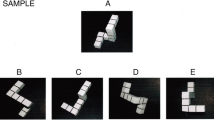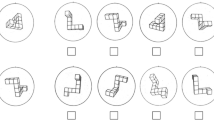Abstract
In spite of the reduced level of experimental control, this large scale study brought some clarity into the relation between mental rotation task (MRT) performance and a number of variables where contradictory associations had previously been reported in the literature. Clear sex differences in MRT were observed for a sample of 134,317 men and 120,783 women, with men outperforming women. There were also MRT differences as a function of sexual orientation: heterosexual men performed better than homosexual men and homosexual women performed better than heterosexual women. Although bisexual men performed better than homosexual men but less well than heterosexual men, no significant differences were observed between bisexual and homosexual women. MRT performance in both men and women peaked in the 20–30 year range, and declined significantly and markedly thereafter. Both men and women showed a significant negative correlation between left and right digit finger ratio and MRT scores, such that individuals with smaller digit ratios (relatively longer ring finger than index finger) performed better than individuals with larger digit ratios.




Similar content being viewed by others
Notes
The variables from which the compliance index was computed were: sex, age, country, ethnic group, level of education, health, dyslexia, asthma, hyperactivity, writing hand, cigarettes, alcohol, sexual activity, medication, drug use, hand clasping, height, chest, waist, hips, attraction to men, attraction to women, left index, left ring, right index, right ring, mental rotation score, line test, memory test.
References
Austin, E. J., Manning, J. T., McInroy, K., & Mathews, E. (2002). A preliminary investigation of the associations between personality, cognitive ability and digit ratio. Personality and Individual Differences, 33, 1115–1124.
Bailey, R. D., Foote, W. E., & Throckmorton, B. (2000). Human sexual behavior: A comparison of college and Internet surveys. In M. H. Birnbaum (Ed.), Psychological experiments on the internet (pp. 141–168). San Diego, CA: Academic Press.
Blanchard, R., & Lippa, R. A. (2007). Birth order, sibling sex ratio, handedness, and sexual orientation of male and female participants in a BBC internet research project. Archives of Sexual Behavior, 36, DOI: 10.1007/s10508-006-9159-7
Brown, W. M., Finn, C. J., Cooke, B. M., & Breedlove, S. M. (2002). Differences in finger length ratios between self-identified “butch” and “femme” lesbians. Archives of Sexual Behavior, 31, 117– 121.
Cohen, J. (1988). Statistical power analysis for the behavioral sciences (2nd ed.). Hillsdale, NJ: Lawrence Erlbaum Associates.
Cohen, K. M. (2002). Relationships among childhood sex-atypical behavior, spatial ability, handedness, and sexual orientation in men. Archives of Sexual Behavior, 31, 129–143.
Coolican, J., & Peters, M. (2003). Sexual dimorphism in the 2D/4D ratio and its relation to mental rotation performance. Evolution and Human Behavior, 24, 179–183.
Fink, B., Neave, N., & Manning, J. T. (2003). Second to fourth digit ratio, body mass index, waist-to-hip ratio, and waist-to-chest ratio: Their relationships in heterosexual men and women. Annals of Human Biology, 30, 728–738.
Gladue, B. A., & Bailey, J. M. (1995). Spatial ability, handedness, and human sexual orientation. Psychoneuroendocrinology, 20, 487–497.
Hall, L. S., & Love, C. T. (2003). Finger-length ratios in female monozygotic twins discordant for sexual orientation. Archives of Sexual Behavior, 31, 23–28.
Halari, R., Hines, M., Kumari, V., Mehrotra, R., Wheeler, M., Ng, V., et al. (2005). Sex differences and individual differences in cognitive performance and their relationship to endogenous gonadal hormones and gonadotropins. Behavioral Neuroscience, 1149, 104–117.
Hampson, E., & Moffat, S. D. (2004). The psychobiology of gender: Cognitive effects of reproductive hormones in the adult nervous system. In A. H. Eagly, A. E. Beall, & R. J. Sternberg (Eds.), The psychology of gender (2nd ed., pp. 38–64). New York: Guilford Press.
Hausmann, M., Slabbekoorn, D., van Goozen, S. H., Cohen-Kettenis, P. T., & Gunturkun, O. (2000). Sex hormones affect spatial abilities during the menstrual cycle. Behavioral Neuroscience, 114, 1245–1245.
Jordan, K., Wüstenberg, T., Heinze, H-J., Peters, M., & Jäncke, L. (2002). Women and men exhibit different cortical activation patterns during mental rotation tasks. Neuropsychologia, 40, 2397–2408.
Kimura, D. (2002). Sex hormones influence human cognitive pattern. Neuroendocrinology Letters, 23(Suppl. 4), 67–77.
Manning, J. T. (2002). Digit ratio: A pointer to fertility, behavior and health. New Brunswick, NJ: Rutgers University Press.
Manning, J. T., Churchill, A. J. G., & Peters, M. (2007). The effects of sex, ethnicity, and sexual orientation on self-measured digit ratio (2D:4D). Archives of Sexual Behavior, 36, DOI: 10.1007/s10508-007-9171-6
Manning, J. T., Scutt, D., Wilson, J., & Lewis-Jones, D. I. (1998). The ratio of 2nd to 4th digit length: A predictor of sperm numbers and levels of testosterone. Human Reproduction, 13, 3000–3004.
Manning, J. T., & Taylor, R. P. (2001). 2nd to 4th digit ratio and male ability in sport: Implications for sexual selection in humans. Evolution and Human Behavior, 22, 61–69.
Maylor, E. A., Reimers, S., Choi, J., Collaer, M. L., Peters, M., & Silverman, I. (2007). Gender and sexual orientation differences in cognition across adulthood: Age is kinder to women than to men regardless of sexual orientation. Archives of Sexual Behavior, 36, DOI: 10.1007/s10508-006-9155-y.
McCormick, C. M., & Teillon, S. M. (2001). Menstrual cycle variation in spatial ability: Relation to salivary cortisol levels. Hormones and Behavior, 39, 29–38.
McCormick, C. M., & Witelson, S. F. (1991). A cognitive profile of homosexual men compared to heterosexual men and women. Psychoneuroendocrinology, 16, 459–473.
McFadden, D., Loehlin, J. C., Breedlove, S. M., Lippa, R. A., Manning, J. T., & Rahman, Q. (2005). A reanalysis of five studies on sexual orientation and the relative length of the 2nd and 4th fingers (the 2D:4D ratio). Archives of Sexual Behavior, 34, 341–356.
McFadden, D., & Shubel, E. (2003). The relationships between otoacoustic emissions and relative lengths of fingers and toes in humans. Hormones and Behavior, 43, 421–429.
Neave, N., Menaged, M., & Weightman, D. R. (1999). Sex differences in cognition: The role of testosterone and sexual orientation. Brain and Cognition, 41, 245–262.
Peters, M. (2005). Sex differences and the factor of time in solving Vandenberg & Kuse mental rotation problems. Brain and Cognition, 57, 176–184.
Peters, M., Laeng, B., Latham, K., Jackson, M., Zaiyouna, R., & Richardson, C. (1995). A redrawn Vandenberg & Kuse Mental Rotations Tests: Different versions and factors that affect performance. Brain and Cognition, 28, 39–58.
Peters, M., Lehmann, W., Takahira, S., Takeuchi, Y., & Jordan, K. (2006). Mental rotation test performance in four cross-cultural samples (n=3367): Overall sex differences and the role of academic program in performance. Cortex, 42, 1005–1014.
Rahman, Q., & Wilson, G. D. (2003). Large sexual-orientation-related differences in performance on mental rotation and judgment of line orientation tasks. Neuropsychology, 17, 25–31.
Reimers, S. (2007). The BBC internet study: General methodology. Archives of Sexual Behavior, 36, DOI: 10.1007/s10508-006-9143-2.
Sanders, G., Bereczkei, T., Csatho, A., & Manning, J. (2005). The ratio of the 2nd to 4th finger length predicts spatial ability in men but not women. Cortex, 41, 789–795.
Sanders, G., & Wright, M. (1997). Sexual orientation differences in cerebral asymmetry and in the performance of sexually dimorphic cognitive and motor tasks. Archives of Sexual Behavior, 26, 463–480.
Silverman, I., & Phillips, K. (1993). Effects of estrogen changes during the menstrual cycle on spatial performance. Ethology and Biology, 14, 257–270.
Tuttle, G. E., & Pillard, R. C. (1991). Sexual orientation and cognitive abilities. Archives of Sexual Behavior, 20, 307–318.
van Anders, S. M., & Hampson, E. (2005). Testing the prenatal androgen hypothesis: Measuring digit ratios, sexual orientation and spatial abilities in adults. Hormones and Behavior, 47, 92–98.
Vandenberg, S. G., & Kuse, A. R. (1978). Mental rotations, a group test of three-dimensional spatial visualization. Perceptual and Motor Skills, 47, 599–604.
Voracek, M., Manning, J. T., & Ponocny, I. (2005). Digit ratio (2D:4D) in homosexual and heterosexual men from Austria. Archives of Sexual Behavior, 34, 335–340.
Voyer, D., Voyer, S., & Bryden, M. P. (1995). Magnitude of sex differences in spatial abilities: A meta-analysis and consideration of critical variables. Psychological Bulletin, 117, 250–270.
Wegesin, D. J. (1998). A neuropsychologic profile of homosexual and heterosexual men and women. Archives of Sexual Behavior, 27, 91–108.
Witelson, S. F., Beresh, H., & Kigar, D. L. (2006). Intelligence and brain size in 100 postmortem brains: Sex, lateralization and age factors. Brain, 129, 386–398.
Woolley, C. S., Gould, E., Frankfurt, M., & McEwen, B. S. (1990). Naturally occurring fluctuation in dendritic spine density on adult hippocampal pyramidal neurons. Journal of Neuroscience, 10, 4035–4039.
Acknowledgements
We are grateful to BBC TV Science for commissioning this research, and to the BBC Science and Nature website for programming and hosting the study. This work was supported by NSERCC Grant A 7054 to Michael Peters.
Author information
Authors and Affiliations
Corresponding author
Rights and permissions
About this article
Cite this article
Peters, M., Manning, J.T. & Reimers, S. The Effects of Sex, Sexual Orientation, and Digit Ratio (2D:4D) on Mental Rotation Performance. Arch Sex Behav 36, 251–260 (2007). https://doi.org/10.1007/s10508-006-9166-8
Received:
Accepted:
Published:
Issue Date:
DOI: https://doi.org/10.1007/s10508-006-9166-8




